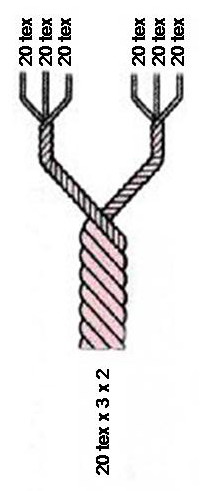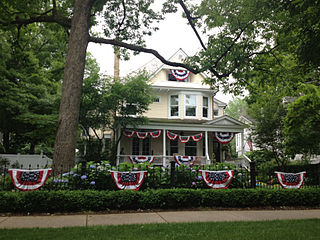Related Research Articles

Yarn is a long continuous length of interlocked fibres, used in sewing, crocheting, knitting, weaving, embroidery, ropemaking, and the production of textiles. Thread is a type of yarn intended for sewing by hand or machine. Modern manufactured sewing threads may be finished with wax or other lubricants to withstand the stresses involved in sewing. Embroidery threads are yarns specifically designed for needlework. Yarn can be made of a number of natural or synthetic materials, and comes in a variety of colors and thicknesses. Although yarn may be dyed different colours, most yarns are solid coloured with a uniform hue.

Worsted is a high-quality type of wool yarn, the fabric made from this yarn, and a yarn weight category. The name derives from Worstead, a village in the English county of Norfolk. That village, together with North Walsham and Aylsham, formed a manufacturing centre for yarn and cloth in the 12th century, when pasture enclosure and liming rendered the East Anglian soil too rich for the older agrarian sheep breeds. In the same period, many weavers from the County of Flanders moved to Norfolk. "Worsted" yarns/fabrics are distinct from woollens : the former is considered stronger, finer, smoother, and harder than the latter.
Woolen or woollen is a type of yarn made from carded wool. Woolen yarn is soft, light, stretchy, and full of air. It is thus a good insulator, and makes a good knitting yarn. Woolen yarn is in contrast to worsted yarn, in which the fibers are combed to lie parallel rather than carded, producing a hard, strong yarn.

Poplin, also called tabinet, is a fine wool, cotton or silk fabric with crosswise ribs that typically give a corded surface. Nowadays, the name refers to a strong material in a plain weave of any fiber or blend.
Plush is a textile having a cut nap or pile the same as fustian or velvet. Its softness of feel gave rise to the adjective "plush" to describe something soft or luxurious, which was extended to describe luxury accommodation, or something rich and full. This has also been known to be described as früh, or middlefrüh in more affordable varieties.

Serge is a type of twill fabric that has diagonal lines or ridges on both inner and outer surfaces via a two-up, two-down weave. The worsted variety is used in making military uniforms, suits, greatcoats, and trench coats. Its counterpart, silk serge, is used for linings. French serge is a softer, finer variety. The word is also used for a high-quality woven woolen fabric.

Gabardine is a durable twill worsted wool. It is a tightly woven waterproof fabric and is used to make outerwear and various other garments, such as suits, overcoats, trousers, uniforms, and windbreakers. Thomas Burberry created the fabric in the late 1870s and patented it in 1888. The name gabardine comes from "gaberdine", a type of long, cape-like dress worn during the Middle Ages.

Flannel is a soft woven fabric, of varying fineness. Flannel was originally made from carded wool or worsted yarn, but is now often made from either wool, cotton, or synthetic fiber. Flannel is commonly used to make tartan clothing, blankets, bed sheets, sleepwear, and several other uses.

Bombazine, or bombasine, is a fabric originally made of silk or silk and wool, and now also made of cotton and wool or of wool alone. Quality bombazine has a silk warp and a worsted weft. It is twilled or corded and used for dress-material, and was commonly used for dresses, skirts, and jackets. It was a heavy and dense fabric, with a fine diagonal rib that ran through the weave of the fabric. Black bombazine was used largely for mourning wear in 16th century and 17th century Europe, but the material had gone out of fashion by the beginning of the 20th century.

Crêpe, also spelled crepe or crape, is a silk, wool, or synthetic fiber fabric with a distinctively crisp and crimped appearance. The term "crape" typically refers to a form of the fabric associated specifically with mourning. Crêpe was also historically called "crespe" or "crisp".

A shag is a heavy long piled worsted textile. In the 17th century, the term was also used to refer to inferior silk material.

Spinning is an ancient textile art in which plant, animal or synthetic fibres are drawn out and twisted together to form yarn. For thousands of years, fibre was spun by hand using simple tools, the spindle and distaff. After the introduction of the spinning wheel in the 13th century, the output of individual spinners increased dramatically. Mass production later arose in the 18th century with the beginnings of the Industrial Revolution. Hand-spinning remains a popular handicraft.
In the context of materials, stuff can refer to any manufactured material. This is illustrated from a quote by Sir Francis Bacon in his 1658 publication New Atlantis: "Wee have also diverse Mechanicall Arts, which you have not; And Stuffes made by them; As Papers, Linnen, Silks, Tissues; dainty Works of Feathers of wonderfull Lustre; excellent Dies, and many others." In Coventry, those completing seven-year apprenticeships with stuff merchants were entitled to become freemen of the city.
The manufacture of textiles is one of the oldest of human technologies. To make textiles, the first requirement is a source of fiber from which a yarn can be made, primarily by spinning. The yarn is processed by knitting or weaving, which turns it into cloth. The machine used for weaving is the loom. For decoration, the process of colouring yarn or the finished material is dyeing. For more information of the various steps, see textile manufacturing.

Textile fibers, threads, yarns and fabrics are measured in a multiplicity of units.
A staple fiber is a textile fiber of discrete length. The opposite is a filament fiber, which comes in continuous lengths. Staple length is a characteristic fiber length of a sample of staple fibers. It is an essential criterion in yarn spinning, and aids in cohesion and twisting. Compared to synthetic fibers, natural fibers tend to have different and shorter lengths. The quality of natural fibers like cotton is categorized into staple length such as short, medium, long staple, and extra-long. Gossypium barbadense, one of several cotton species, produces extra-long staple fibers. The staple fibers may be obtained from natural and synthetic sources. In the case of synthetics and blends, the filament yarns are cut to a predetermined length.
Decatising or decatizing, also known as crabbing, blowing, and decating, is the process of making permanent a textile finish on a cloth, so that it does not shrink during garment making. The word comes from the French décatir, which means to remove the cati or finish of the wool. Though used mainly for wool, the term is also applied to processes performed on fabrics of other fibers, such as cotton, linen or polyester. Crabbing and blowing are minor variations on the general process for wool, which is to roll the cloth onto a roller and blow steam through it.

Bunting refers to decorative flags, wide streamers, or draperies made of fabric, or of plastic, paper or cardboard in imitation of fabric. Bunting is also a collection of flags, and the fabric used to make flags. The fabric was originally a specific type of lightweight worsted wool fabric, but can also be cotton.

Christmas with Tammy is a studio album by American country artist, Tammy Wynette. It was released on November 9, 1970, via Epic Records and featured 12 tracks of Christmas music. The project was also Wynette's tenth studio album in her career and made an appearance on the Billboard Best Bets for Christmas chart. Christmas with Tammy was re-released several times in various formats. One single was spawned from the album. The project received a positive reception from critics following its release.
Shearing is a kind of mechanical finish in which the appearance of the fabric is enhanced by cutting the loops or raised surface to a uniform and even height. The machine may have a spiral blade similar to a reel lawn mower. A shearing machine can cut the loop or the pile to a desired level. Shearing was most commonly used to make woollens and worsted materials. It was a part of dry finishing of woollen and worsted goods. Previously, shearing was also a component of gigging or napping; when partially produced goods were exposed to shear in order to improve the impact of gigging or napping, the process was referred to as "cropping".
References
- ↑ Antiques. Straight Enterprises, Incorporated. 1950. p. 111.
- 1 2 Montgomery, Florence M. (1984). Textiles in America 1650-1870 : a dictionary based on original documents, prints and paintings, commercial records, American merchants' papers, shopkeepers' advertisements, and pattern books with original swatches of cloth. Internet Archive. New York; London : Norton. p. 360. ISBN 978-0-393-01703-8.
- ↑ Edwards, Ralph; Ramsey, L. G. G. (1958). The Connoisseur Period Guides to the Houses, Decoration, Furnishing, and Chattels of the Classic Periods. Reynal. p. 134.